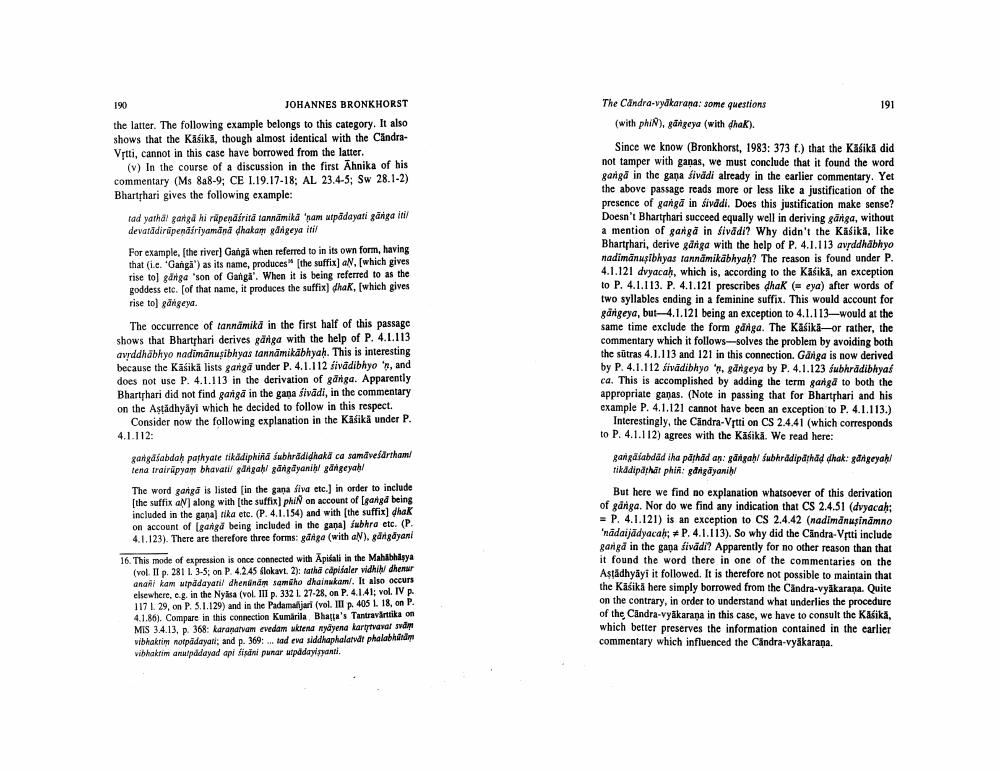Book Title: Candra Vyakarna Some Questions Author(s): Johannes Bronkhorst Publisher: Johannes Bronkhorst View full book textPage 5
________________ 190 JOHANNES BRONKHORST the latter. The following example belongs to this category. It also shows that the Kafikā, though almost identical with the CåndraVrtti, cannot in this case have borrowed from the latter. (v) In the course of a discussion in the first Ahnika of his commentary (Ms 8a8-9; CE 1.19.17-18; AL 23.4-5; Sw 28.1-2) Bharthari gives the following example: radyathal ganga hi ripenäsritā tannāmika nami wpadayati ganga til devatādirupenāíriyamana dhakam gangeya itil For example, the river] Gangā when referred to in its own form, having that (i.c. 'Ganga') as its name, produces the suffix) aN. [which gives rise to ganga 'son of Ganga'. When it is being referred to as the goddess etc. (of that name, it produces the suffix) dhak, (which gives rise to gangeya. The occurrence of tarnamika in the first half of this passage shows that Bharthari derives ganga with the help of P. 4.L.113 avrddhabhyo nadimanusibhyas tannāmikäbhyah. This is interesting because the Käsikä lists ganga under P. 4.1.112 sivadibhyo 'n, and does not use P. 4.1.113 in the derivation of ganga. Apparently Bharthari did not find garigă in the gana sivādi, in the commentary on the Astădhyayi which he decided to follow in this respect. Consider now the following explanation in the Kašika under P. 4.1.112: The Candra-vydkarana: some questions (with phil), gārgeya (with dhak). Since we know (Bronkhorst, 1983: 373 f.) that the Kasika did not tamper with ganas, we must conclude that it found the word garigd in the gana fivadi already in the earlier commentary. Yet the above passage reads more or less like a justification of the presence of ganga in šivadi. Does this justification make sense? Doesn't Bharthari succeed equally well in deriving gánga, without a mention of gargā in fivadi? Why didn't the Kafika, like Bharthari, derive gänga with the help of P. 4.1.113 avrddhabhyo nadimănuşibhyas tannāmikābhyah? The reason is found under P. 4.1.121 dvyacah, which is, according to the Kāśikä, an exception to P. 4.1.113. P. 4.1.121 prescribes dhak (= eya) after words of two syllables ending in a feminine suffix. This would account for gängeya, but-4.1.121 being an exception to 4.1.113—would at the same time exclude the form ganga. The Kasika-or rather, the commentary which it follows-solves the problem by avoiding both the sütras 4.1.113 and 121 in this connection. Ganga is now derived by P. 4.1.112 Sivadibhyo . gangeya by P. 4.1.123 śubhradibhyas ca. This is accomplished by adding the term ganga to both the appropriate ganas. (Note in passing that for Bharthari and his example P. 4.1.121 cannot have been an exception to P. 4.1.113.) Interestingly, the Candra-Vrtti on CS 2.4.41 (which corresponds to P. 4.1.112) agrees with the Kāśika. We read here: gangaiahdadiha pathad an gängah/ Subhradipathad dhak: gdrigeyahl rikadipahat phir: gdigdyanih But here we find no explanation whatsoever of this derivation of ganga. Nor do we find any indication that CS 2.4.51 (dvyacah; = P. 4.1.121) is an exception to CS 2.4.42 (nadimanusināmno 'nādai jādyacah; P.4.1.113). So why did the Candra-Vrtti include ganga in the gana sivadi? Apparently for no other reason than that it found the word there in one of the commentaries on the Astādhyāyi it followed. It is therefore not possible to maintain that the Kasika here simply borrowed from the Candra-vyäkarana. Quite on the contrary, in order to understand what underlies the procedure of the Candra-Vyakarana in this case, we have to consult the Kašikā, which better preserves the information contained in the earlier commentary which influenced the Candra-vyākarana. gangasabdah pathyale nikddiphina subhradidhaka ca samdve drtham! tena frairūpyam bhavati gdigahl gängd yanih/ gangeyah/ The word ganga is listed in the gana siva etc.) in order to include [the suffix analong with (the suffix] phi on account of [ganga being included in the gana) tika etc. (P.4.1.154) and with (the suffix] dhak on account of Iganga being included in the gana) subhra etc. (P. 4.1.123). There are therefore three forms: ganga (with aŅ), gangayari 16. This mode of expression is once connected with Apidali in the Mahabhiya (vol. II p. 281 L. 3-5: on P. 4.2.45 Slokart. 2): tatha capisaler widhih/ dhenar anal kam atpadayatil dhenanam samiho dhain kam/. It also occurs elsewhere, eg. in the Nyksa (vol. III p. 332 1. 27-28. on P. 4.1.41; vol. IV p. 117 L. 29, on P. 5.1.129) and in the Padama jarl (vol. III p. 405 1. 18, on P. 4.1.86). Compare in this connection Kumarila Bhatta's Tantravirttika on MIS 3.4.13, p. 368: karanavam evedam wbtena nyayena karttavat svdiyi vibhakrim notpadayati; and p. 369: ... tad ena siddhaphaladt phalabhūtdim vibhakrim aruddayad api sisäni punar utpadayisyanti.Page Navigation
1 ... 3 4 5 6 7 8 9 10
